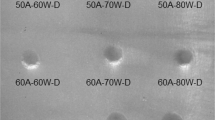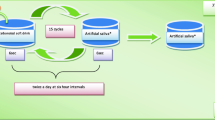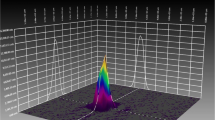Abstract
Objectives
This study was aimed to examine the effects of intensity and frequency on the cutting efficiency of the Er,Cr:YSGG laser in the enamel and dentin.
Methods
The percentage of air/water in spray during laser irradiation was fixed at 85%/75% for the enamel and dentin surfaces. Nine points on flattened surfaces of the enamel and dentin were irradiated with the Er,Cr:YSGG laser for approximately 1 s using various intensities (3.0, 4.0, and 5.0 W for enamel, 2.0, 2.5, and 3.0 for dentin) and frequencies (20, 30, and 40 Hz) (n = 10). A high-speed video microscope was used to record each laser irradiation on the tooth surface. A slow video image was used to count the number of water micro-explosions yielded on the tooth surface during the laser irradiation. A surface roughness tester was used to measure the depth of the tiny dimple developed by the laser irradiation on each specimen. The value of each dimple depth was divided by the number of water micro-explosions (pulse). This allowed for the calculation of the cutting depth per pulse. Data were statistically analyzed with two-way analysis of variance. Following laser irradiation, several representative specimens were observed using a scanning electron microscope.
Results
Significant effects of both intensity and frequency of the laser irradiation on the cutting depths of the enamel and dentin surfaces were observed (p < 0.05). The values of the cutting depths per pulse in the high-intensity groups were significantly larger than those in the low-intensity groups for both enamel and dentin (p < 0.05). The value of the cutting depth per pulse at high frequency was significantly smaller than that at low frequency for both enamel and dentin (p < 0.05).
Conclusion
Both intensity and frequency of the laser had significant effects on the cutting of the enamel and dentin; the cutting efficiency was increased when the intensity increased and the frequency decreased.




Similar content being viewed by others
References
Holcomb DW, Young RA (1980) Thermal decomposition of human tooth enamel. Calif Tissue Int 31:189–201
Hadley J, Young DA, Eversole LR, Gornbein JA (2000) A laser-powered hydrokinetic system for caries removal and cavity preparation. JADA 131:777–785
Altshuler GB, Belikov AV, Sinelnik YA (2001) A laser-abrasive method for the cutting of enamel and dentine. Lasers Surg Med 28:435–444
Fried D, Ashouri N, Breunig TM, Shori RK (2002) Mechanism of water augmentation during IR laser irradiation of dental enamel. Lasers Surg Med 31:186–193
Mir M, Meister J, Franzen R, Sabounchi SS, Lampert F, Gutknecht N (2008) Influence of water-layer thickness on Er:YAG laser ablation of enamel of bovine anterior teeth. Lasers Med Sci 23:451–457
Mir M, Gutknecht N, Poprawe R, Vanweersch L, Lampert F (2009) Visualising the procedures in the influence of water on the ablation of dental hard tissue with erbium:yttrium–aluminium–garnet and erbium, chromium:yttrium–scandium–gallium-garnet laser pulses. Lasers Med Sci 24:365–374
Kuščer L, Diaci J (2013) Measurements of erbium laser-ablation efficiency in hard dental tissues under different water cooling conditions. J Biomed Opt 18:108002
Rego Filho FAMG, Dutra-Corrêa M, Nicolodelli G, Bagnato VS, de Araujo MT (2013) Influence of the hydration state on the ultrashort laser ablation of dental hard tissues. Lasers Med Sci 28:215–222
Sun Y, Yuan F, Lv P, Wang D, Wang L, Wang Y (2015) Method to control depth error when ablating human dentin with numerically controlled picosecond laser: a preliminary study. Lasers Med Sci 30:1435–1441
Van As G (2004) Erbium lasers in dentistry. Dent Clin N Am 48:1017–1059
Cavalcanti BN, Lage-Marques JL, Rode SM (2003) Pulpal temperature increases with Er:YAG laser and high-speed handpieces. J Prosthet Dent 90:447–451
Shinkai K, Takada M, Kawashima S, Suzuki M, Suzuki S (2019) Effects of the percentage of air/water in spray on the efficiency of tooth ablation with erbium, chromium: yttrium-scandium-gallium-garnet (Er,Cr:YSGG) laser irradiation. Lasers Med Sci 34:99–105
Chen H, Li H, Sun YC, Wang Y, Lü PJ (2016) Femtosecond laser for cavity preparation in enamel and dentin: ablation efficiency related factors. Sci Rep 6:20950. https://doi.org/10.1038/srep20950
Zhang S, Chen T, Li-hong G (2012) Scanning electron microscopy study of cavity preparation in deciduous teeth using the Er:YAG laser with different powers. Lasers Med Sci 27:141–144
Raucci-Neto W, Chinelatti MA, Palma-Dibb RG (2008) Ablation rate and morphology of superficial and deep dentin irradiated with different Er:YAG laser energy levels. Photomed Laser Surg 26:523–529
Hossain M, Nakamura Y, Yamada Y, Kimura Y, Matsumoto N, Matsumoto K (1999) Effects of Er,Cr:YSGG laser irradiation in human enamel and dentin: ablation and morphological studies. J Clin Laser Med Surg 17:155–159
Iwata A, Hayasihara H, Yasuo K, Onda K, Zennyuu K, Fukui M, Tanaka Y, Yoshikawa K, Yamamoto K (2010) Study on dental hard tissues irradiated by an Er, Cr: YSGG laser: surface characteristics and cutting efficiency. Oper Dent 53:147–158
Kato C, Taira Y, Suzuki M, Shinkai K, Katoh Y (2012) Conditioning effects of cavities prepared with an Er,Cr:YSGG laser and an air-turbine. Odontology 100:164–171
Takada M, Shinkai K, Kato C, Suzuki M (2015) Bond strength of composite resin to enamel and dentin prepared with Er,Cr:YSGG laser. Dent Mater J 34:863–871
Takada M, Suzuki M, Haga-Tsujimura M, Shinkai K (2017) Effect of adhesive system application for cavities prepared with erbium, chromium: yttrium scandium gallium garnet laser on rat dental pulp tissue. Odontology 105:300–310
Funding
This study was supported in part by Grants-in-Aid for Scientific Research (C) from the Japan Society for the Promotion of Science (no. 23234567).
Author information
Authors and Affiliations
Corresponding author
Ethics declarations
Conflict of interest
The authors declare that they have no competing interests.
Ethical approval
The present study was reviewed and approved by The Human Research Committee of the Nippon Dental University School of Life Dentistry at Niigata (approval number: ECNG-H-9).
Additional information
Publisher’s note
Springer Nature remains neutral with regard to jurisdictional claims in published maps and institutional affiliations.
Rights and permissions
About this article
Cite this article
Shinkai, K., Suzuki, M. & Suzuki, S. Effects of intensity and frequency of erbium, chromium:yttrium-scandium-gallium-garnet (Er,Cr:YSGG) laser irradiation on tooth ablation. Laser Dent Sci 4, 123–129 (2020). https://doi.org/10.1007/s41547-020-00099-3
Received:
Accepted:
Published:
Issue Date:
DOI: https://doi.org/10.1007/s41547-020-00099-3




